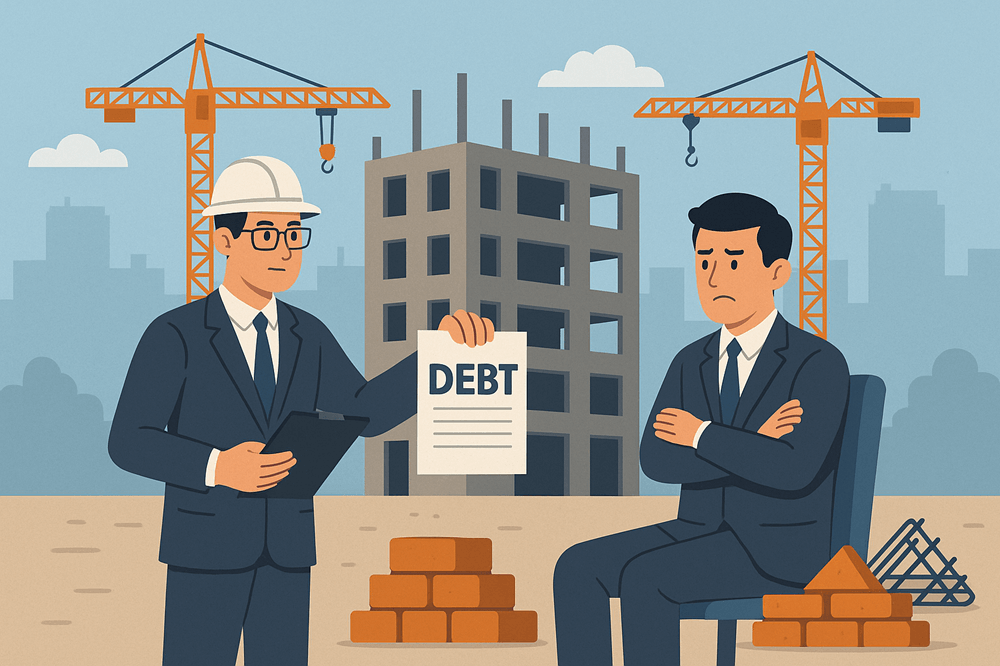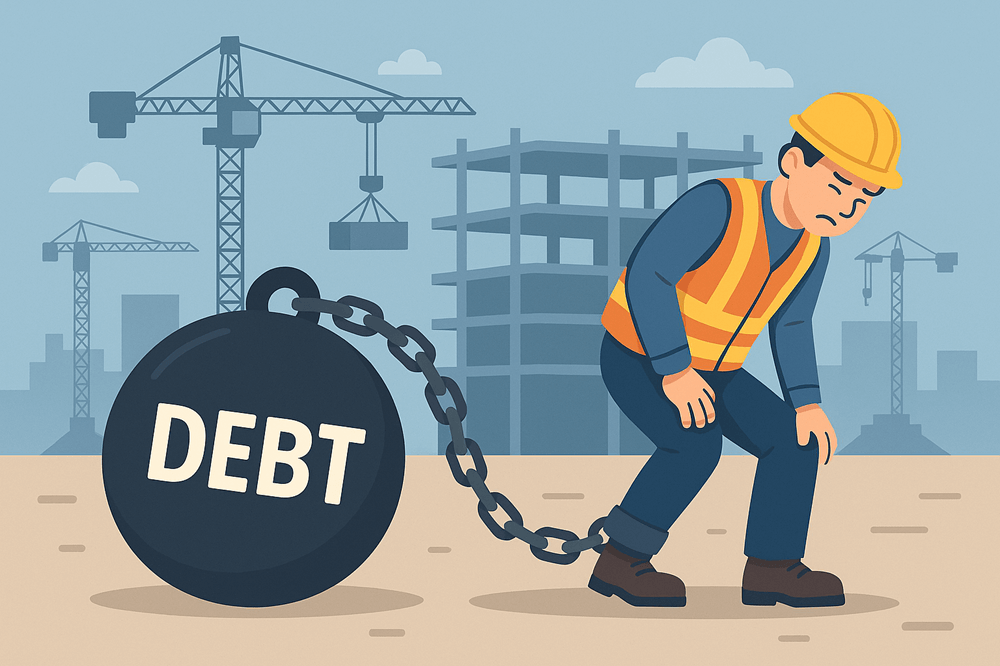Construction Debt Collection
Construction debt collection requires in-depth legal expertise and a thorough understanding of the unique characteristics of the construction industry. Unlike other sectors, construction debt arises from multidimensional relationships between investors, main contractors, and subcontractors, creating unique challenges. In a volatile economy, construction debt disputes are on the rise, calling for professional handling grounded in a solid legal framework. This article by TNTP analyzes key aspects of construction debt collection in Vietnam.
1. What Is Construction Debt Collection?
Construction debt collection refers to the process of compelling parties to fulfill their payment obligations in construction contracts. The construction sector is characterized by long project cycles, large contract values, and complex multi-party relationships. Accordingly, construction debts commonly arise from:
- The debt between the investor and the main contractor;
- The debt between the main contractor and subcontractors;
- The debt between the main contractor and suppliers:
The governing legal framework includes the Civil Code 2015, the Law on Construction 2014 (amended in 2020), the Commercial Law 2005, and related guiding instruments.
2. Legal Basis for Construction Debt Recovery in Vietnam
To lawfully and effectively pursue construction debt collection, parties must understand the applicable legal provisions:
- Civil Code: Provides rules on payment obligations under contracts, liability for damages, and late payment interest. This serves as the legal foundation for claiming both principal and late payment interest..
- Law on Construction: Sets out detailed provisions on construction contract payments, rights and obligations of the parties, payment conditions, penalties, and compensation for damages in the construction sector.
- Commercial Law: Contains specific remedies for breach of contractual obligations, including contractual penalties and damages.
- Decrees, circulars, and other guiding instruments further clarify the above laws.
Mastery of these regulations enables parties to identify the most effective legal solutions to recover construction debts swiftly and efficiently.
3. Common Causes of Construction Debt Disputes
Disputes relating to construction debt arise from various causes, among which the most common include:
- Delayed payment by investors due to financial difficulties, mismanagement of funds, or intentional withholding of payments.
- Refusal or partial withholding of payment by investors or contractors over disagreements on quantities or quality of works.
- Changes in project scope or valuation resulting from design modifications or additional works not yet formalized by a written contract amendment.
- Financial distress or insolvency of contractors or subcontractors leads to inability to pay.
4. Construction Debt Collection Process in Vietnam
The construction debt collection process usually involves four steps:
- Step 1: Identify and verify the construction debt amounts subject to collection.
- Step 2: Debt reconciliation with the debtor.
- Step 3: Negotiate repayment terms, prioritizing a settlement on payment schedules and methods without resorting to litigation.
- Step 4: Litigation or arbitration if negotiations fail
5. Where to Resolve Construction Debt Disputes?
Depending on the dispute resolution clause in the contract, the parties may choose among the competent authorities for resolving construction debt disputes, including:
- People’s Courts: Courts of competent jurisdiction for civil and commercial disputes under the law.
- Arbitration centers: Used where the parties have entered into an arbitration agreement
- Specialized dispute resolution mechanisms: For contracts subject to international standards such as FIDIC, disputes may be referred to a Dispute Adjudication Board (DAB) before adjudication by courts or arbitral tribunals.
6. How Long Does Construction Debt Collection Take?
The duration of construction debt collection depends on the debtor’s willingness to pay and the complexity of the case:
- If the debtor demonstrates good faith and financial capacity, settlement may be achieved within 6 – 12 months.
- In cases where proceedings are initiated before an arbitration, the timeframe for construction debt collection typically ranges from 2 to 4 months. However, this period may be prolonged if the debtor refuses to voluntarily comply with the arbitral award and enforcement proceedings must be initiated, or if the debtor files an application to terminate the award, provided there are legal grounds to do so.
With litigation, the timeframe for construction debt collection usually extends from 1 to 3 years. More complex and high-value disputes may extend beyond this period, particularly where enforcement proceedings are required due to the debtor’s failure to voluntarily comply with the court’s judgment or decision.
7. Can Contractors Claim Both Principal and Interest?
This is a concerned matter of the contractor when proceeding construction debt collection. Contractors are fully entitled to demand payment of both principal and interest where the investor breaches its contractual payment obligations.
Pursuant to Article 418 of the Civil Code 2015, if the contract provides for penalty interest in the event of a breach, the aggrieved party may impose such penalty on the breaching party. The penalty must not exceed 8% of the value of the breached contractual obligation (Article 301 of the Commercial Law 2005) or 12% for state-funded projects (Clause 2, Article 146 of Law on Construction 2014).
In addition, contractors may claim late payment interest if the investor delays payment, regardless of whether the contract expressly provides for it. Such interest is calculated based on the prevailing average overdue interest rate on the market at the time of payment (Article 306 of the Commercial Law 2005) or capped at 20% of the overdue amount (Articles 357 and 468 of the Civil Code 2015).
8. Required Documents for Construction Debt Recovery
Creditors must prepare a complete and well-documented file to facilitate effective construction debt collection, including:
- Construction contract and appendices;
- Construction work acceptance records;
- Project handover documents, payment invoices;
- Debt reconciliation statements;
- VAT invoices, receipts, and agreed payment schedules;
- Evidence of contract performance, such as handover minutes, delivery notes, transport documents, and site photographs,…
- Correspondence (letters, emails, official notices) regarding payment demands during the debt collection process.
9. Construction Debt Collection Services in Vietnam
Construction debt collection requires specialized expertise and a strong command of construction law. TNTP provides comprehensive legal services from initial consultation to authorized representation to protect clients’ rights, including:
- Reviewing legal documents, assessing debt collection prospects, and advising on optimal strategies;
- Representing clients in negotiations with debtors;
- Drafting all necessary legal documents;
- Representing clients before courts or arbitration.
Construction debt collection is a complex process that demands both legal expertise and practical experience. Success depends on sound strategy, well-prepared documentation, and rigorous execution. With a team of experienced lawyers, TNTP is committed to supporting clients in recovering construction debts and securing maximum protection of their interests.






